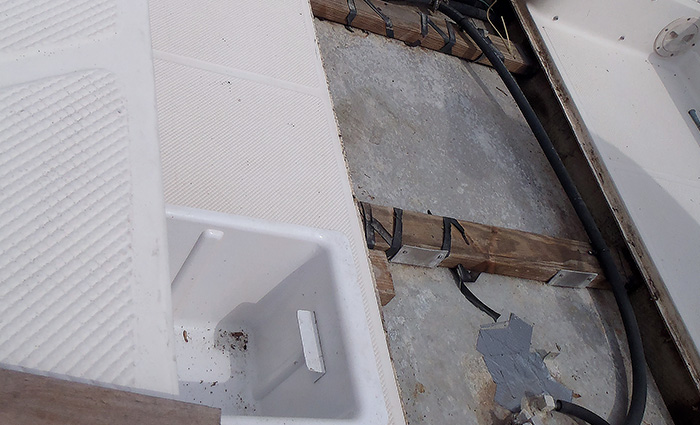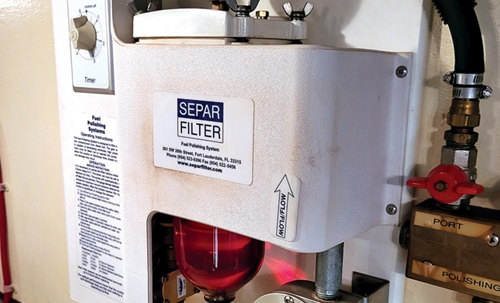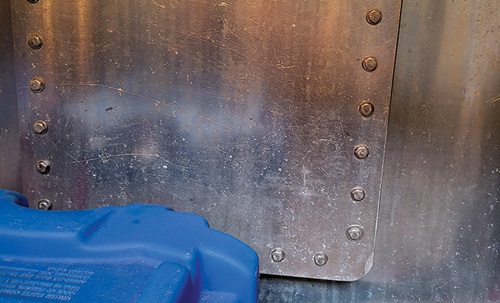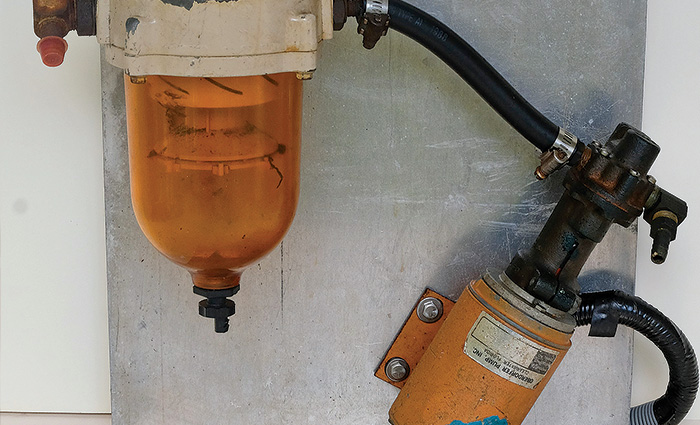Advertisement
Keep your fuel tank – and the fuel in it – spick and span to avoid gunk being sucked up and clogging the system. Here’s how

When the need to clean your fuel tank arises, good access is crucial, such as in this example of a tank and hoses accessible via a large opening in the cockpit deck. Photo: Frank Lanier
Despite the plethora of magic potions and elixirs sold to prevent it, dirty fuel tanks happen. Fuel polishing can help, depending on how often and thoroughly you do it. But at some point, you may need to clean the fuel tank itself of deposits and gunk on the walls and bottom.
Most people think cleaning a fuel tank is a job for professionals, but with the proper tools and planning, many competent DIYers can accomplish the task safely and efficiently. Although each installation will present its own unique set of requirements, here are some general guidelines and safety precautions that can be applied to most tank cleaning jobs.
Our focus here is cleaning diesel fuel tanks only, not gasoline or any other types. There may be some overlapping of tools and techniques, but we can’t recommend DIY cleaning gasoline tanks for safety reasons.
In this article, we’ll be covering two likely scenarios: The first is that your tank and the fuel in it need cleaning, however, both can be addressed by fuel polishing. The second is that fuel polishing isn’t enough, so physically accessing the interior and cleaning the tank is required.

Fuel polishing equipment on Tom Neale’s present boat, Chez Nous, a Camano 41. Photo: Tom Neale

Installing fuel tank ports for cleaning can be a daunting proposition. Access is something to note when boat shopping. Photo: Tom Neale
Scenario 1: Fuel Polishing
“Fuel polishing” is simply cleaning the fuel inside your tank by removing it from the tank, cycling it through a filtering system, and returning the cleaned fuel to the tank. This process removes suspended impurities such as dirt or water. Fuel polishing systems can be either permanently mounted or a portable unit.
The primary components of a fuel polishing system are an electric fuel pump, a large fuel filter (such as those by Racor), fuel hoses, and the various fittings and valves needed to connect the intake and return of the polishing system to the fuel tank.
Permanently installed systems are typically separate from the engine fuel supply, although, in some cases, they can be plumbed to use the engine’s primary fuel filter. This is not ideal unless the engine fuel system features selectable dual primary filters, which allows use of the standby or “spare” filter for polishing. Fixed systems can be operated 24/7 if necessary (depending on design) and do not require the engine to be running.
A portable fuel polishing system is connected when actively polishing fuel but removed afterward. Depending on design and tank access ports, a portable system can also be used to assist when cleaning the fuel tank (more on this in a moment).
When designing a fuel polishing system, fuel should be drawn from the bottom of the tank. The fuel pickup for the engine typically stops a couple of inches from the bottom of the tank to avoid sucking up contaminants – the very stuff you want to reach when polishing.
The time required to cycle through all the fuel in your tank will depend on the polishing system components. When purchasing or designing a system, however, three to four hours is a reasonable goal. The system should also be designed to allow easy access for inspection and filter replacement (you’ll be doing this a lot when polishing dirty fuel). As with your primary fuel system, installing a vacuum gauge (to monitor filter condition) is highly recommended.
Don’t have the space or desire to install a polishing system? You can also hire mobile fuel-polishing services to come to your boat.
Remove the fuel
There are several ways you can remove the residual fuel from your tank in preparation for cleaning, but let’s get one thing straight — a shop vac isn’t one of them! Here are six recommended options for getting the fuel out:
- Manual pump, such as diaphragm-style bilge pump. A manual pump means no sparks or potential explosions.
- Length of hose to siphon the fuel out, assuming the receiving container can be positioned beneath the fuel tank. A squeeze-bulb pump (common to outboard gas tanks) will allow you to easily start a siphon. A self-priming jiggler siphon may also work to drain fuel, although it might also clog repeatedly when used to drain a particularly dirty tank.
- A gear fuel pump such as those made by Oberdorfer (oberdorferpumps.com).
- If you use an electric pump, ensure it is ignition-protected, suitable for the fuel you are pumping, and located in a well-ventilated area, preferably outside the boat.
- A portable fuel polishing system can also be used to remove unusable fuel.
- A fixed fuel polishing system may also be an option, depending on how it is configured.
Whether you siphon or pump, have someone monitor the receiving container to avoid overflow. An old diesel jerry can works great for this, as it can also be closed and used to safely hold or transport fuel for recycling or disposal. — F.L.
Scenario 2: Tank Cleaning
Your diesel fuel tank should be cleaned at the first sign of contamination, such as irregular running, particulate in the filter parts, or rapid or constant clogging of fuel filters. Particulates and biocontaminants can settle on the bottom of the tank and turn to sludge, which can clog filters and even cause damage to engines and generators if not addressed. The takeaway here? Clean your tank at the first sign of trouble, before things get out of control. If you have a fuel polishing system, use it regularly.
If the tank must be cleaned, common sense dictates removing as much fuel as possible first. The easiest way to do this is by burning the fuel through normal boat use. If you’ve waited until the fuel is unusable, get ready for some pumping, hauling, and possible disposal dilemmas as you work your way toward the dregs at the bottom of the tank.
When it comes to tank cleaning, the more access the better. Ideally your tank has access plates or ports that can removed for internal cleaning and they’re located above a low point in the tank (for easier removal of residue during the cleaning process). If not, you’ll have to use what’s provided (fill hose inlets, vents, fuel gauge sending unit ports) and sprinkle liberally with a little MacGyver-style ingenuity.
If you have a smaller craft and can remove the tank for cleaning, you’ll have additional options, such as rotating it upside down to drain while cleaning. Installing access ports may be an option in some cases, however, due to the safety concerns of cutting into a fuel tank possibly filled with volatile fumes, it’s a job best left for the pros.

A DIY fuel polisher made aboard years ago by Tom Neale, our technical editor. It uses an aluminum sheet, Racor filter, and 12-volt Oberdorfer gear pump. Hoses (not shown) were used to cycle and polish fuel and, with a wand, to vacuum the tank (suction hose) or wash the walls, bottom, and corners (output hose). If the output hose has a smaller diameter than the input hose, the washing pressure is increased. Photo: Tom Neale
Get cleaning
Once the tank is completely drained of fuel (see “Remove the Fuel” on page 85), the real fun begins. With sufficient access, cleaning the tank may be as simple as wiping down the inside with an aqueous degreaser like Simple Green or a similar product from companies like those by CRC (crcindustries.com) or Blaster (blasterproducts.com). In many cases, a rag moistened with diesel fuel will suffice.
Never use solvents or chemicals such as acetone or MEK, which can create a hell’s broth of flammable fumes that aren’t safe to breathe. (We have also not recommended specific chemical “crud-busters.” This is a decision you should make for your specific needs based on product information provided by the manufacturer and other reliable sources.) Although less volatile than gasoline, don’t be complacent when it comes to diesel fuel fumes – particularly as you never know what added chemicals suppliers or workers have introduced into the tank.
Tanks with limited access or internal baffles may require power washing. A standard fan-tipped lance can be used on the more accessible areas, but for the out-of-sight areas, you’ll want to use an extension tipped with a multidirectional tank-cleaning nozzle, such as those available from Bete (bete.com), McMaster-Carr (mcmaster.com), and Lechler (lechlerusa.com).
An articulating extension for the wand and nozzle may be necessary because of the spray-shadowing effect of the tank’s baffles. Power washing can be very dangerous if the ejected fluid is directed toward your skin, so never point the wand at body parts or other people. A water-resistant endoscope with light (we like the Teslong NTS300 Pro from teslong.com) can be very helpful for locating the crud on the walls, seams, and bottom of the tank and especially around baffles. Also helpful is a handheld light such as StreamLight’s Dualie 3AA with Color-Rite technology (streamlight.com). It has a beam for distance but also a second light, which helps to see colors on murky tank walls.
Diesel deposits can leave a tarry substance stuck to tank bottoms, corners, and other areas. Like road tar, it may be difficult to remove, but it may also break up at unwanted times (such as during a storm or when transiting a rough inlet) and should be removed.
Removal can be accomplished using the power washer mentioned above, which may use water and/or one of the safe crud-cutting solutions on the market. Another option (for removing tar and other dirt) is outfitting the return hose of a portable fuel polishing system with a wand and directing a stream of diesel fuel around tank walls and wherever there is crud. This should wash the crud off if you have a good, powerful pump, particularly when used in conjunction with appropriate cleaning substances.
Sometimes you can remove the tarry substance using the pickup tube from a fuel evacuation pump like a vacuum or by using grabbers. Water and tank crud should ideally drain to a low point under your access port while cleaning, where it can be pumped out. It is important to not leave any tar or other particles in the tank.
After cleaning, dry the interior of the tank with a clean cloth by hand (if it can be reached) or by using extension grippers and rags. You can also provide good ventilation and simply let the tank air dry.
Pressure washing a fuel tank is a dirty job and can cause injury if not done properly, so be sure to follow all manufacturer directions closely and wear all necessary safety gear. Protection from fumes may also be needed depending on your situation, in which case an ignition-protected, industrial-type fan is great for providing additional ventilation.
Fuel tank cleaning safety tips
- Work in a well-ventilated area when cleaning your tank, preferably outside.
- Never clean your tank around any open flames or sparks.
- Wear appropriate protective equipment such as gloves, goggles, or a face mask.
- Follow manufacturer guidelines when using tools or chemicals.
- Be aware of what you’re doing and use common sense! — F.L.
Diesel disposal
Your marina likely has disposal or recycling programs available that can help with disposal of old fuel. If not, there may be other options. Crud-laden diesel fuel can also normally be disposed of through any used oil recycling station (such as those found in automotive parts stores) as long as it’s not contaminated with gasoline or solvents.
